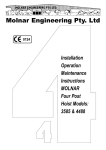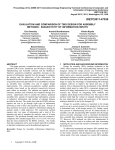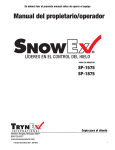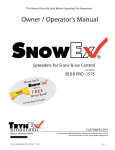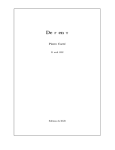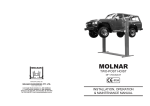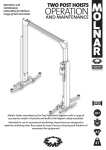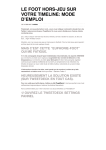Download Scissor User Manual
Transcript
MOLNAR SCISSOR LIFT HOIST SL02 INSTALLATION, OPERATION & MAINTENANCE MANUAL Page 1 of 22 Rev B – Dec 2009 OPTIONAL 240 VOLT SINGLE PHASE MINIMUM REQUIREMENTS FOR ELECTRICAL CONNECTION OF MOLNAR HOISTS Important: All installations should be carried out by suitably qualified persons. Failure to comply may void warranty. The following information is a guide only based on the latest standards as set out in AS/NZS 3000, for installations outside of Australia & New Zealand refer to local standards regulations. Circuit Breakers should be of "D" curve type (motor start, high inrush current) - Ratings given as a maximum for circuit & motor protection based on DOL selection guide. Voltage operating range: -6% to + 10% of motor nameplate Voltage. Motor Voltage 240V Operation range 225V to 264V. Cable sizes are given as a guide only for a maximum cable length to 30m. Longest cable runs and in area where supply voltage is below motor voltage, Calculation should be made to ensure Voltage Drop will not fall below minimum operating voltage. When installed motors must be tested under Full Load checking Voltage at motor terminals. Motor 2.2kW 240V Single-phase model CWC3640F Full Load Current Min Cable Size Circuit Breaker 12.4 Amps 2.5mm 2 core + earth 1 phase 32 Amp 10kA Recommended Clipsal4CB132/10 or equivalent Page 2 of 22 Rev B – Dec 2009 No person should be permitted to operate the MOLNAR SCISSOR LIFT HOIST without first studying the operating instructions on top of page 9 and safety precautions on page 11. This manual should be kept in a safe place and referred to as necessary The installation requirements on page 19 must be completed and the certificate on the inside back cover must be signed by the installer. The guarantee card must be completed and returned to MOLNAR ENGINEERING PTY. LTD. When installed in tropical environments it is advisable to raise the hoist to full height when not in use overnight or on weekends, to minimise condensation forming inside the cylinder which may lead to corrosion of cylinder bore or shaft. This vehicle hoist is not designed to be used for steam cleaning nor be installed in the open exposed to the elements. Vehicle hoists installed under such conditions are not covered by our guarantee. Page 3 of 22 Rev B – Dec 2009 Model SL02 Complies fully with the Australian Standard 1418.9-1996 Page 4 of 22 Rev B – Dec 2009 CONTENTS Introduction……………………………………………………………………6-7 Floor Requirements…………………………………………………………….8 Operating Instructions………………………………………………………….9 Maintenance…………………………………………………………………...10 Safety Precautions……………………………………………………………11 Replacement Parts List………………………………………………….……12 Parts Identification……………………………………………………….……13 Installation Instructions……………………………………………………….14 Wiring Diagram………………………………………………………………..15 Electronic Diagram……………………………………………………………16 Hydraulic Circuit Diagram…………………………………………………….17 Installation Requirements…………………………………………………….18 Certification…………………………………………………………………….19 SPECIFICATIONS Overall width 2093mm Overall length 3664mm Maximum raised height 1830mm Minimum lowered height platform 188mm Lifting time (working height) approx. 55 secs Lowering time (3tonnes) approx 30 secs Electric motor - 3 phase, 2.2kw, 2700 rpm, 415 volts, 50 hertz (Optional) - Single phase, 2.2kw, 2850 rpm, 240 volts, 50 hertz Hoist mass - 1080 kg Hydraulic oil - Castrol Hyspin AWH46, Shell Tellus T46, Mobil DTE 25, BP Bartran HV46 or equivalent SWL - 3000kg (3,0 tonnes) Air supply - Compressed air to max 7 bar, 6mm dia min supply line. Max Vehicle Size Max 3100mm Max 1890mm Min 2200mm The Manufacturer reserves the right to alter these features and specifications without notice Page 5 of 22 Rev B – Dec 2009 INTRODUCTION Here is the MOLNAR SCISSOR LIFT HOIST, a space saving wheel-free hoist and its many advantages. It has been purposely designed for space saving and to give versatility and profitability to the largest garage and smallest service station. Safe, strong, simply built to give years of trouble-free service. The MOLNAR SCISSOR LIFT HOIST embodies many features that make it the most up-to-date equipment for quicker and more profitable service. SAFE AND EFFICIENT OPERATION Due to an electro hydraulic system, which gives years of trouble free service. Raising and lowering of vehicle is achieved through an electronic remote controller. Sturdy safety toggles ensure against any failure with additional flow controls at the base of each cylinder, in the event of a hydraulic line breakage. INSTALLATION The MOLNAR SCISSOR LIFT HOIST is fast and simple to install. It is also ideal for upper floor level where excavation is not possible. The hoist is surface mounted, a feature which means lower overall cost. Compared with similarpriced hoists, the MOLNAR SCISSOR LIFT HOIST can be quickly, easily and economically re-sited. Page 6 of 22 Rev B – Dec 2009 INTRODUCTION FOR SPEEDIER SERVICE With the MOLNAR SCISSOR LIFT HOIST maximum accessibility is assured. For safe and fast efficient servicing giving the hoist unlimited advantages. With this lifting method the suspension springs are relaxed, facilitating service and repair work. Some other uses are wheel service, brake adjustment, spraying or sealing. EASY TO OPERATE The MOLNAR SCISSOR LIFT HOIST is operated with the greatest of ease. The rubber pads are easily placed in position by one man. The operator has full confidence due to the extensions catering for long wheelbase vehicles. The vehicle is immediately wheel- free and stable at any height. Page 7 of 22 Rev B – Dec 2009 FLOOR REQUIREMENTS FOR MODEL SL02 These notes are for your guidance prior to installation. 1. It is the user’s responsibility to provide a satisfactory site area. 2. The floor should be a single reinforced concrete slab. Min concrete thickness = 100mm Min plan dimensions of 3800mm x 2200mm Prepared base 100mm thickness of quarry rubble compacted to 95% SL81 reinforcement mesh Min thickness of concrete above mesh = 65mm 25Mpa concrete 3. For correct installation of the Scissor Lift Hoist, the floor must be flat and level at the anchorage points. A level tolerance between bases of 8mm is allowable and 10mm front to rear. Check with straight edge and spirit level. 4. Recommended anchor bolts are expansion sleeve type anchors 20mm diameter with a minimum length of 82mm. Use the manufacturers recommended installation procedures. NOTE: Some authorities do not approve expanding type anchorage devices. 5. If there is any doubt about the quality of the floor, a replacement slab should be installed. Use a qualified person to design the replacement slab. 6. No liability for any damages will be accepted should you install the hoist on an unsuitable floor. Page 8 of 22 Rev B – Dec 2009 OPERATING INSTRUCTIONS 1. Drive vehicle on forward to front wheels rest on stops 2. Place the four rubber pads under edge of vehicle at the four jack points. 3. Press up button and raise vehicle to required height. Do not go under vehicle until load rests on safety. 4. When vehicle reaches maximum height a limit switch will come into operation and stop hoist. When hoist has stopped, press down button until load rests on safety mechanism. 5. While lifting the vehicle a clacking sound should be noticeable which indicates the safety mechanism is operating. If this sound is not heard, immediately cease using the hoist and call an authorised service agent. 6. The following steps are to be taken when lowering the hoist. Press the down button twice within 2 seconds and continue to hold, the hoist will raise up automatically for 2 seconds. Safety will disengage then hoist will begin to lower. 7. If vehicle is to be worked on at an intermediate position, release down button. Allow 2 seconds then press down button once to reapply safety mechanism. 9. To lower to ground level, repeat step 6 10. WARNING. Do not go under vehicle under any circumstances while vehicle is being raised or lowered. 11. WARNING. Load must be evenly distributed between both lifting platforms If load is unbalanced reposition vehicle. DO NOT lower on to locks at different heights. Page 9 of 22 Rev B – Dec 2009 MAINTENANCE DAILY Check safety mechanism is functioning correctly. WEEKLY Clean the bottom tracks and safety with compressed air (do not use water) MONTHLY 1. Check safety mechanism operation. 2. Check condition of shafts, shaft locks and bushes. 3. Check overall cleanliness. 4. Clean roller tracks, spray rollers and safety toggle shafts with an aerosol based multi purpose lubricant. 6 MONTHLY 1. Check condition of extensions and lubricate with an industrial grade type silicone based spray. 2. Check oil leaks from cylinders. 3. Check oil leaks at pipe joints. 4. Check anchor bolts. 5. Lubricate top and bottom roller side guides and tracks with an industrial grade type silicone based spray. 6. Lubricate safety air cylinders (two drops of light oil down the inlet fitting). YEARLY Service and safety inspection on the hoist must be performed by a competent person. This inspection must be recorded. If the 12 monthly service and safety inspection is not performed, the warranty is null and void. NOTE: Yearly service must include removal of rollers to inspect, clean and lubricate bushes and pins. 2 YEARLY Hydraulic oil and filter should be replaced. Fill Oil Tank to Oil Level Line with Shell Tellus T46 oil, Mobil DTE25 oil, Castrol Hyspin AWH46 oil, BP Bartran HV46 oil or equivalent. Check and clean inline air filter element, access to the element is made by unscrewing the large hex nut in the inlet end of the filter body. NOTE: After cleaning workshop floor or hoist, to maintain hoist efficiency we advise to lubricate roller bearings and safety toggle shafts, as per monthly maintenance instructions point 4. Page 10 of 22 Rev B – Dec 2009 SAFETY PRECAUTIONS DON'T 1.Do not try to lift anything beyond the maximum capacity 3000 Kg. 2. Do not operate without first ascertaining the safety of people and equipment in the area 3. Do not go under car or make adjustments while hoist is in operation. 4. Do not try to adjust rubber pads engaged to jack points while the hoist is in operation. 5. Do not fail to inspect safety devices periodically to see they are in proper working condition. 6. Do not make unauthorised changes to safety equipment. In emergency consult this manual or your local dealer. 7. Do not fail to protect operating switch from water if the hoist is used for car washing. 8. Do not try to adjust relief valve as it has been set at maximum operating efficiency. 9. Do not turn off mains power while hoist is operating. 10. Do not attempt to operate the hoist from under vehicle. Page 11 of 22 Rev B – Dec 2009 REPLACEMENT PARTS LIST ITEM NO. QTY. PART NO. DESCRIPTION 1 1 SL0200100 Base Assembly 4 1 SL0200400 Pivot block assembly 5 1 SL0200500 Pivot bush full 6 1 SL0200600 Pivot bush half 10 2 Air Cylinder Assembly 11 2 SL0201100 Outer scissor assembly 12 1 SL0201200 Torsion Bar Assembly 14 2 M8_10 15 2 SL0201500 Inner scissor assembly 20 2 Circlip DIN 471 - 30 x 1.5 20 2 Circlip DIN 471 - 25 x 1.2 21 2 Circlip DIN 471 - 42 x 1.75 22 1 SL0201900 Shaft center pivot 23 2 SL0202300 Acetal Bush2 23 2 SL0202300 Acetal Bush2 26 2 SL0202600 Acetal Bush3 26 2 SL0202600 Acetal Bush3 27 2 Circlip DIN 471 - 12 x 1 28 1 SL0202800 Shaft Run up pivot 29 1 SL0202900 Ramp Assembly 30 2 SL0203000 Run up assembly 31 1 MF8511500 Flow Restrictor Cylinder 32 1 FP8211300 Spring (Cylinder Check Valve) 33 1 SL0203300 Spring retainer 35 1 SL0203500 Cylinder welded assembly 38 1 MF8511000 Wear ring 13691WR 43 1 SL0204300 Rod assembly 44 1 SL0204400 Rod pivot bush 45 1 PL9204500 Extensions 46 2 SL0204600 Top Pivot Pin Assembly 47 2 SL0204700 Acetal bush4 48 2 SL0204800 Top section assembly 49 2 SL0204900 Rod roller shaft guide 50 2 SL0205000 Bush top roller 51 2 SL0205100 Roller top 52 1 SL0205200 Shaft top roller 55 2 SL0205500 Bush lower roller 56 2 SL0205600 Lower Roller 57 1 SL0201900 Shaft bottom roller 58 1 SL0205800 Air piston 59 1 SL0205900 Cylinder retaining bush 60 1 Circlip DIN 471 - 25 x 1.2 61 2 BS114 63 1 SL0206300 Air Cylinder 65 2 SL0206500 Safety Bracket 65 1 Circlip DIN 472 - 26 x 1.2 66 2 SL0206600 Safety Toggle 67 2 SL0206700 Safety Bush 70 2 SL0207000 Run off 71 1 SL0207100 Cylinder return spring 73 1 SL0207300 Centre cover 2 ISO 4762 M8 x 12 --- 12N M8 x 12 cap screw Page 12 of 22 Rev B – Dec 2009 Page 13 of 22 Rev B – Dec 2009 INSTALLATION INSTRUCTION 1. Position hoist to installation position on two bearers. 2. Open wooden create and layout contents. 3. Remove packing straps and blocks. 4. Position and bolt down through the 6 fastening holes. The recommended fastener is a 20mm expansion sleeve type fastener, min length of 82mm. Where shims are required to correct for out of level floors, the shims must support the full length of the roller track. Safety Toggle Fastening holes Fastening holes 5. Locate the control unit in an appropriate position away from the hoist. A qualified electrician must wire the control unit. Refer to Electrical diagram Page 15. Fill tank through breather vent with the supplied Hydraulic oil. 6. Dry filtered compressed air at 6 to 7 bar line pressure is required to operate the safety mechanism. The control unit is supplied via an inline particulate filter which requires a ¼”BSP threaded fitting from a min 6mm ID supply line. 7. Attach the hydraulic hose from the control unit to the hoist. The connection is under the Left (passenger side) wheel run up ramp. Insure all hydraulic fittings are tight and not leaking, refer to page 15 Betabite Hydraulics Assembly Instructions. Optional connection can be made under Right wheel run up ramp by relocating the pipework end plug fitting. 8. Connect electrical limit switch wires and pneumatic airline to connection points at front left hand of hoist. Secure with The Hydraulic line and U shape cover. Optional connections can be made under Right wheel run up ramp. 9. The hydraulic hose, electrical wires and pneumatic airline must be protected from accidental damage. Use 6mm (1/4”) wall plugs to secure supplied covers to the ground. Extra covers are available, please contact your local supplier. 10. Raise the hoist and inspect hoist for correct operation and that the safety toggles are locking. 11. Install the run up/run off ramps and centre cover onto the hoist. Swap pickup extension so handles are on the outside of the scissor lift. 12. NOTE: For efficient operation of your hoist please adhere to the maintenance schedule Page 14 of 22 Rev B – Dec 2009 Assembly Instructions 1. Cut the tube to length and file ends square. 2. Remove internal and external burrs from tube end. 3. We always highly recommend that joints are pre-made whilst the coupling body is held firmly in a bench vice. 4. Ascertain that all the detail parts of the coupling are suitably lubricated, especially the internal body cone, the rear of the ferrule and the internal thread of the nut. The lubrication process is recommended on all fittings, however, on stainless steel couplings the use of a quality lubricant is imperative. Betalube, a copper based paste is highly recommended and available from Betabite Hydraulics or your local distributor. Please note after assembly, fittings to be used on Oxygen lines should be fully degreased. 5. Slide the nut onto the tube, followed by the ferrule, the open end of the nut should be towards the end of the tube, and similarly, the cutting or smaller end of the ferrule should point towards the tube end. 6. Present the tube, nut and ferrule to the coupling body, making sure that tube passes cleanly through the nut and ferrule & butts firmly against the step (abutment face) provided in the coupling body. Screw the nut onto the coupling body until finger tight. 7. Hold the tube in one hand and with the correct sized spanner in the other hand, tighten the nut until the ferrule is felt to just grip the tube. This point is determined by rotation or slightly rocking the tube. From this point, the nut should be tightened 1 ¼ to 1 ½ turns from the initial ring grip to obtain a fully effective cutting action. On larger sizes of fitting, an extension to the spanner is highly recommended to maximise leverage and minimise effort. 8. If the nut is now removed, the ferrule will have cut its own seating on the tube and whilst it will be found to rotate, it cannot be moved towards the tube end. The ‘joint’ may now be re-assembled, by re-tightening of the nut until significant resistance is felt and then increase for a further ⅛ to ¼ of a turn. The above procedure must be followed closely to ensure a safe and successful joint. 9. Betabite fittings correctly made can be broken repeatedly, when not under pressure and re-made without affecting their pressure tightness and leak-proof quality Pressure rating tables for your safety, convenience and peace of mind Imperial sizes > 1” OD or ¾” NB > 1 ¼” OD or 1” NB > 1 ½” OD or 1 ¼” NB Hydraulic 690 bar (10,000 psi) 552 bar (8,000 psi) 414 bar (6,000 psi) Gas 345 bar (5,000 psi) 276 bar (4,000 psi) 207 bar (3,000 psi) Metric sizes (L) Light series (L) Light series (S) Heavy series (S) Heavy series 6 to 18mm 22 to 42mm 6 to 14mm 16 to 30mm 315 bar (4,568 psi) 160 bar (2,320 psi) 630 bar (9,135 psi) 400 bar (5,800 psi) www.betabite.co.uk Page 15 of 22 Rev B – Dec 2009 ELECTRICAL DIAGRAM WIRING TO THIS UNIT TO COMPLY WITH AS3000 Page 16 of 22 Rev B – Dec 2009 ELECTRONIC DIAGRAM Page 17 of 22 Rev B – Dec 2009 HYDRAULIC DIAGRAM Page 18 of 22 Rev B – Dec 2009 INSTALLATION REQUIREMENTS INSTALLER MUST CHECK THE FOLLOWING LIST WHEN INSTALLING A MOLNAR SCISSOR LIFT HOIST 1. A suitable floor where the hoist is to be bolted down must have a level surface to ensure the hoist base frames lie flat. When the hoist is bolted down check all nuts and bolts to ensure they are correctly tightened. 2. Check for possible transport damage or dislocation. 3. When power is connected to the hoist terminal box, the motor rotation direction must be clockwise when viewed from above. Consult with electrical contractor to reverse motor rotation direction if incorrect. 4. Check safety mechanism for loose nuts or bolts. 5. Check compressed air supply pressure is at 6 to 7 bar. 6. Check operation of safety mechanism on both sides, then test hoist with load. 7. Recheck hoist operation. Demonstrate the hoist to the operator. 8. Very Important 8.1 Instruct operator how to use the hoist, how the safety mechanism works and where to place lifting pads when lifting vehicles. 8.2 Point out maintenance requirements and that they should be checked monthly. 8.3 Point out that by law, the operator and/or owner are responsible for the maintenance and safe operation of the hoist. 9. When all the above points are checked the certificate must be signed by the installer. Page 19 of 22 Rev B – Dec 2009 CERTIFICATION I hereby certify that the hoist has been checked and is in a safe operating condition and that the purchaser/operator has been adequately instructed to operate the hoist. Purchaser………………………………………….. Model No……………SL02……………………….. Serial No……………………………………………. Date………………………………………………… Installation by……………………………………… Address…………………………………………….. ……………………………………………………… Name………………………………………………. Signature…………………………………………… Date………………………………………………… Page 20 of 22 Rev B – Dec 2009 Page 21 of 22 Rev B – Dec 2009 MANUFACTURED BY: MOLNAR ENGINEERING PTY. LTD. A.B.N. 54 007 740 794 16-20 Coglin Street, Brompton, S.A. 5007 AUSTRALIA Telephone: (08) 8346 6893, (08) 8346 6894, (08) 8346 8006 Fax: (08) 8346 0097. Email: [email protected] www.molnarhoists.com.au Page 22 of 22 Rev B – Dec 2009






















